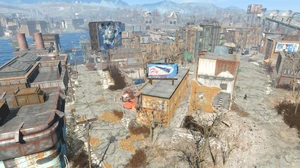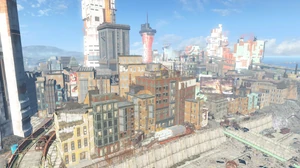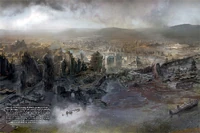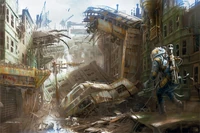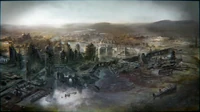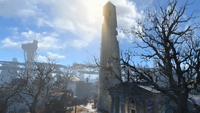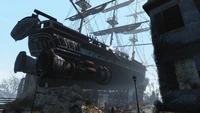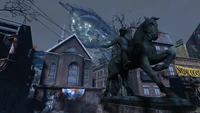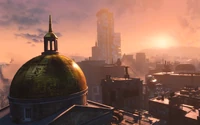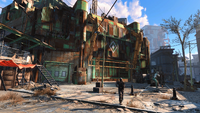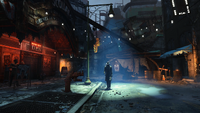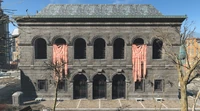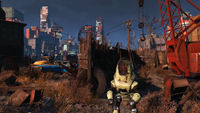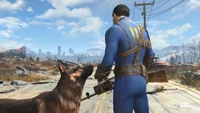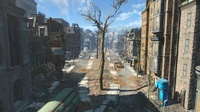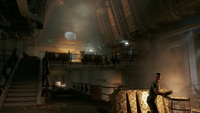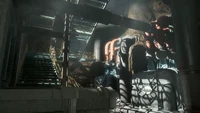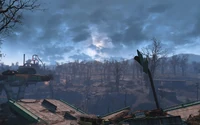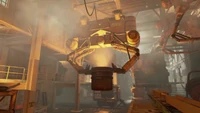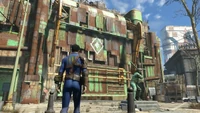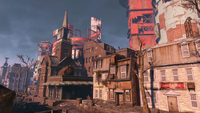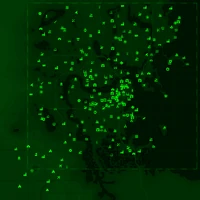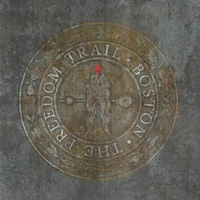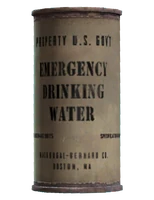Boston was the capital city of the former state of Massachusetts in the New England Commonwealth until the nuclear holocaust of 2077.
The downtown core of Boston is one of the most chaotic areas featured in the Fallout series. The streets are fought over between various raiders, Triggermen gangs, super mutants and even the occasional group of Gunners. This produces frequent bursts of gunfire and explosions. It can be difficult, especially at an early level, to find a safe route through the city. Direct confrontation of the various groups can make for slow progress. However, Boston is unique to the series in the amount of vertical space. Often finding a safer route is a matter of looking up. However, the elevated rooftops are not entirely safe. One should watch for Gunners and super mutants on or near the elevated highway which cuts through the financial district.
As one of the birthplaces of American independence, Boston features countless major landmarks, including Bunker Hill, Massachusetts State House, the Old North Church and many, many more, complemented by remnants of American corporate glory, such as the Mass Fusion Building. Unlike many other cities, Boston also features one unusually successful Vault in the form of Vault 81, found at the westernmost limit of the city. Though it suffered due to the passage of time, it became a prominent settlement by the year 2287. The much larger Vault 114, located Boston Common, within Park Street station was not completed by the time of the War.
Background[]

Post-war Boston and impact crater
One of the oldest cities in the United States, Boston was founded on the Shawmut Peninsula in 1630 by Puritan settlers from the Kingdom of Great Britain. It was the scene of several key events of the American Revolution, such as the Boston Massacre, the Boston Tea Party, Paul Revere's "midnight ride," the Battles of Lexington and Concord, the Battle of Bunker Hill and the Siege of Boston. Upon American independence from Great Britain, the city continued to be an important port and manufacturing hub, as well as a center for education and culture.
Located within Suffolk County, the city has expanded beyond the original peninsula through land reclamation and municipal annexations.[Non-game 1] Boston's many firsts include the United States' first public school, first subway system and first public park: Boston Common (1634).
Its rich history attracted tourists despite the overall economic deterioration of the U.S. Those who could did enjoy the various parks, such as the Charles River Esplanade and Boston Common, amusement parks, the beach and the various historical landmarks, such as Bunker Hill, and the Dorchester Heights Monument, and museums like the Museum of Freedom, the USS Constitution and Fort Independence. Winding through downtown is the Freedom Trail. Marked largely with brick, it winds between Boston Common and the Bunker Hill Monument in Charlestown. Linking historical sites and museums significant to the history of the United States, such as the Faneuil Hall, the Old State House and the Paul Revere House. For those who liked sports, there was Fenway Park, which since 1912, has been home to American's favorite pastime, baseball.
Prior to the nuclear holocaust, Boston had a thriving tech industry.[1] The Institute, previously known as the Commonwealth Institute of Technology or CIT, was a prestigious university located in Boston, contributing heavily to the city's research sector with its staff affiliated with various labs, companies, and even federal organizations such as the United States Armed Forces. Robert House was believed to be an alumnus of CIT pre-War. During the Great War, a number of CIT personnel survived by taking refuge in the underground level of the campus. In 2110, the survivors and their descendants founded the Institute, an organization dedicated to furthering pre-War science. The scientific community inhabiting the university-created technologies vastly superior to anything else seen in the wasteland. Androids or "synths," specifically, are one of the creations to come out of the Institute.
During the resource crises of the late 21st century, Boston would transition to run on nuclear power. Municipal plutonium wells were installed across the city, and Mass Fusion installed what was supposedly the first commercial fusion power reactor on homes and buildings across the city. However, in reality behind Mass Fusion's promises of a cleaner tomorrow came even heavier pollution. Their revolutionary fusion reactors were in reality poorly shielded fission reactors, and the resulting nuclear waste outpaced the company's ability to properly dispose of it.[2] Illegal dumping by Mass Fusion and other companies such as Corvega and Saugus Ironworks poisoned the environment around Boston.
The radiation seepage would seep into the rivers, lakes and the harbor like the sewage of old. While man took both legal[3] and physical action against the detritus,[4][5] the local crustaceans would be the first to grow ever larger and poisonous. All of which would be ignored by the Boston Port Authority and the media; the former of who stopped taking calls from activists, particularly of the Nahant Oceanological Society,[6] while the latter would spin the stories relayed to them into pro-government propaganda.
Corrupt to the core, the local municipal services of the Greater Boston area would routinely flout basic safety protocols and misallocate funds. Such as the case with the entire municipal water system. Despite a decade-long (c. 2050—2060) plan of modernizing the city's aged sanitation systems,[Non-game 2] the new equipment procured and updated facilities was of poor quality and use. Such as the case of the Weston water treatment plant, with the catastrophic and systematic failures of the equipment, the facility was forced to compensate both in man-hours and even "experimental" waste water recycling. This lead to a cholera outbreak in 2077; to cover for this, the facility staff and regional municipal utility services would collude with other plants to swap out tainted water for clean, known as the "Weston WELLness press initiative."
This was all compounded by the still functional two hundred year old (at the time) sewage tunnels; built to channel waste water directly to the nearest waterway, they would occasionally overflow with combined sewer and rain water. These were never modernized nor reinforced. Much of these ancient catacombs were crushed by the Great War; what wasn't crushed would either be cut off from the rest of the system or silted up with the harbor itself.
As the Resource Wars continued, the food supply started to dwindle. Rationing sites were set up around Boston, including the Boston Police rationing site. In October 2077, an unknown person smashed the glass of the Roxbury food bank. Soldiers opened fire on civilians, with at least four confirmed dead and eight injured. This incident became known as the Roxbury Food Riot. Food riots started over the city, like in Denver.[7]
The Great War[]
At least two nuclear missiles were launched against the Boston area during the Great War. One strike occurred in the region southwest of Boston proper, slightly limiting the damage to the surrounding area. Ground zero of the missile, however, became a highly dangerous area filled with high levels of radiation and lightning storms, and has in the post-War years become known as the Glowing Sea.[Non-game 3] A lower-yield missile struck Cambridge, leveling an entire neighborhood and leaving a radioactive crater. As a result, Boston survived the war relatively intact compared to areas like Washington, D.C., with places such as Fenway Park having provided safety from the bombs.[8] However, the loss of government and infrastructure led to societal collapse, with looting and violence occurring across the city. Surviving military forces attempted to restore order but ultimately failed.[9]
Post-War, the Commonwealth has been described by Dr. Zimmer as "a war-ravaged quagmire of violence and despair." However, the Commonwealth (which includes Boston) seems to be one of less devastated areas in the post-War USA, so Zimmer's impression seems to be primarily based on the fact that he likely grew up inside the Institute, where the standard of living is much higher.
Neighborhoods[]
Cambridge[]
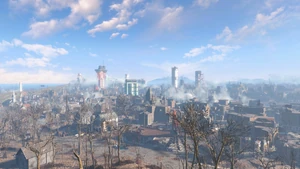
Cambridge was a city in Middlesex County, Massachusetts, in the Boston metropolitan area. The site for what would become Cambridge was chosen in December 1630 because it was located safely upriver from Boston Harbor, and on the north side of the Charles River, which made it easily defensible from attacks by enemy ships. Located at the first convenient Charles River crossing west of Boston, Newe Towne, as it was called at the time, was one of a number of towns founded by the 700 original Puritan colonists of the Massachusetts Bay Colony. Eventually, it was named in honor of the University of Cambridge in Britain, an important center of the Puritan theology embraced by the town's founders.[Non-game 4]
The town expanded greatly before eventually being subsumed into the Greater Boston metropolitan area. Before the Great War, it was famous for the Commonwealth Institute of Technology laying at its heart and numerous prominent R&D centers nearby, such as Greenetech Genetics and Cambridge Polymer Labs. Academic infrastructure constituted a major part of the district, as students continued to flock to CIT in search of higher learning. The Red Line of the Boston MTA provided metro service from Cambridge to downtown Boston via College Square station, while several bridges such as Longfellow Bridge and Ivy League Bridge connected the district to the roads of downtown.
When the Great War brought devastation to the world, Cambridge received a direct hit which leveled an entire block and left a sizable crater in its wake, although much of the district was spared from the devastation. Among the survivors were staff and students of CIT, who eventually founded the Institute in 2110 beneath the CIT ruins, and permanently sealed themselves off from the surface in the 2180s after failed attempts to coexist with the surface and the creation of the molecular relay.[10] Since then, Cambridge has been left to its own devices, divided between ferals clustering around the crater, raider gangs operating along the Charles River, and the odd super mutant warband. Around 2287, Recon Squad Gladius arrived in Cambridge as the third long range recovery expedition sent by the Brotherhood of Steel, but they have fared poorly due to relentless attacks by local wildlife and other inhabitants, human or otherwise.[Non-game 5]
Charlestown[]
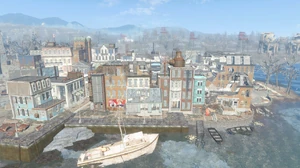
Charlestown is the oldest neighborhood in Boston. Originally called Mishawum by the Massachusett, it is located on a peninsula north of the Charles River, across from downtown Boston, and also adjoins the Mystic River and Boston Harbor. Charlestown was laid out in 1629 by engineer Thomas Graves, one of its early settlers. It was originally a separate town and the first capital of the Massachusetts Bay Colony. In 1775, Charlestown was the site of the Battle of Bunker Hill, a key battle in the Revolutionary War.
Charlestown became a city in 1848 and was annexed by Boston on January 5, 1874. With that, it also switched from Middlesex County, to which it had belonged since 1643, to Suffolk County. It has had a substantial Irish-American population since the migration of Irish people during the Great Irish Famine of the 1840s.[Non-game 6] Prior to the Great War, Charlestown was also home to the regional office of the Bureau of Alcohol, Drugs, Tobacco, Firearms and Lasers, a federal agency involved in a massive investigation of organized crime around Boston.
Separated from Cambridge by an elevated freeway, Charlestown's old wooden row houses and their colonial architecture structures are still present in 2287. The neighborhood is primarily controlled by raiders, with (sometimes hostile) scavengers to the south and along the river. It is dominated by two ancient monuments: Bunker Hill and the U.S.S. Constitution,[Non-game 7] the former of which has since become a hub of regional trade and the latter of which (a primary target for scavengers) is now crashed atop the Weatherby Savings & Loan building, its robotic crew intent on completing its voyage into the seas.
The Fens[]
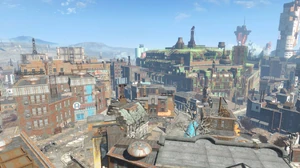
West of Back Bay, this neighborhood's name is derived from its pre-War name, Fenway–Kenmore. The Fens, sometimes called Back Bay Fens, was a parkland and urban wild within the heart of Boston, built in 1870 to serve as a link in the Emerald Necklace park system.[Non-game 8] By the 2070s, the neighborhood was connected to the subway's Green Line via Fens Way station and its locale patrolled by the Boston Police Department from Police Precinct 8. A serial killer known as the Fens Phantom operated in the neighborhood, making his lair in its sewers, killing dozens of civilians and leaving several holotapes addressed to the detective assigned to the case.[11] Fenway Park, home to Boston's baseball team, the Swatting Sultans, was located in the neighborhood and was to be the site of the last game in the 2077 World Series, only interrupted by the bombs falling.
Currently, the Fens is the friendliest neighborhood in all of downtown Boston: it is home to Diamond City, "the Great, Green Jewel of the Commonwealth," the largest and most secure settlement in the Commonwealth, built within Fenway Park; Diamond City security also maintains a relatively safe radius around the city's exterior. The rest of the neighborhood, however, is occupied by various gangs of raider and super mutants (the latter of which are currently forcing out the former).[12][Non-game 9]
East Boston[]
East Boston, nicknamed "Eastie," is a neighborhood of Boston that was created by using land fill to connect five islands: Noddle's; Hog's; Governor's; Bird; and Apple. It is separated from the rest of the city by Boston Harbor and is bordered by Winthrop, Revere, and the Chelsea River. Directly west of East Boston, across Boston Harbor, is the North End and Boston's Financial District.[Non-game 10]
This new territory was annexed by the city of Boston in 1836. By the mid-1800s, the neighborhood would become an influx point for immigrants to the city for well over a century. This influx in population led to rapid growth in the industrialization of the area and subsequently its infrastructural needs. The neighborhood itself was not directly connected to Boston proper until 1904, with the construction of the first subway tunnel to cross the harbor, connecting East Boston to the Financial District;[Non-game 10] a vehicular tunnel would subsequently be built between these two areas as well.[13] Another immigrant-focused accommodation was the repurposing of East Boston Preparatory School, originally a Catholic prep school, into a secular institution serving the immigrant population by local activists.[Non-game 11]
Prior to the Great War, East Boston was home to Boston International Airport, a major East Coast transportation hub,[Non-game 12] located on the southern end of the peninsula. The airport was connected directly to Downtown Boston via the Boston MTA Blue Line but otherwise had no dedicated transit routes across the harbor. Another major construction project in the neighborhood was RB-2851. Jointly operated by General Atomics and the U.S. Army, this massive underground facility was a clandestine experimental Robobrain production site, with its main entrance hidden as a humble RobCo Industries computer service center.
When the nuclear weapons were launched, East Boston was spared from a direct hit, but not the immediate effects. Planes flying to and from Boston Airport fell and crashed into the land (and the surrounding waters), their gigantic metal hulls now landmarks. As most of the land in the neighborhood was land fill, when the land shook liquefaction took hold, sinking some heavier structures. With time, as with the rest of the conurbation, collapse, detritus and lack of maintenance would cause the water runoff system to become ineffective, flooding the neighborhood's lower areas -- a problem exacerbated by rising sea levels.[Non-game 12] The tunnels crossing the harbor between East Boston and central Boston have also collapsed as a result of the devastation.
As of 2287, East Boston is mostly uninhabited, but not completely. The Triggermen have repurposed Easy City Downs, a former horseracing track, into a (rigged) robot racing track. A significant raider gang in the area is based out of East Boston Preparatory School, and is known for harassing traders from Bunker Hill to the west. Boston Airport is plagued by feral ghouls,[Non-game 12] but is quickly secured by the Brotherhood of Steel once they enter the Commonwealth in force. Finally, RB-2851 has been reoccupied by a costumed character, who made it their lair with the intention of using its long-dormant mechanical production lines to help bring order to the chaotic wasteland.
Esplanade[]
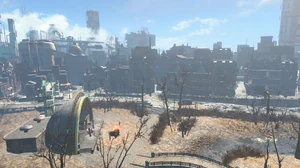
A part of Back Bay, the Charles River Esplanade was a state-owned park along the bank of the Charles River, with the neighborhood including some of the nearby Back Bay urban blocks. The park itself was dedicated as the "Boston Embankment" in 1910, and created as part of the construction of the Charles River Dam. It originally extended to Charlesgate and connected with Olmstead's Emerald Necklace of public parks. However, it went through a major expansion from 1928 to 1936, widening and lengthening the park land.[Non-game 13] Commonwealth Avenue is the main east-west thoroughfare along the southern edge of the neighborhood, parallel to the riverfront Storrow Drive. It runs from the Holy Mission Congregation church in the west to Boston Common in the east. The thoroughfare is divided by a wide median planted with trees, and is lined by pre-War mansions.[Non-game 14][Non-game 15]
Two centuries after the Great War, the Esplanade's waterfront mansions still exhibit the faded grandeur of times gone by. Control of the neighborhood is currently in contest by raiders and Gunners, the latter of which are intent on exploring HalluciGen, Inc., the headquarters of a pre-War biochemical research firm which has since begun leaking chemicals.[Non-game 14] Meanwhile, a secret society calling themselves the Pillars of the Community has made their home within a riverside amphitheater.[14]
Back Bay[]
Originally a tidal bay, Native Americans built fish weirs here; by 1892, however, a filling project would completely fill the area. The project was the largest of a number of land reclamation projects which, beginning in 1820, more than doubled the size of the original Shawmut Peninsula.[Non-game 16] The Esplanade to the north is nominally part of Back Bay; otherwise, the neighborhood is bounded to the west by the Fens and to the east by Boston Common and the Theater District. The Massachusetts Turnpike, a major interstate highway, forms the southern boundary of the neighborhood from the eastern terminus of Mass Pike Tunnel.
This neighborhood was once known for its numerous brownstones, considered one of the best preserved examples of 19th-century urban design in the United States, as well as individual architecturally significant buildings and cultural institutions such as the Boston Public Library or Trinity Church. This, however, didn't stop new construction, such as that of Trinity Tower, which came to dominate the skyline as one of Boston's tallest skyscrapers (second only to the Mass Fusion building in the Financial District).[Non-game 17] Prior to the Great War, the corporate HQ of Wilson Atomatoys (creator of the Giddyup Buttercup) was located here. Another notable storefront was that of Hubris Comics, which doubled as a television studio for the planned adaptation of the locally popular franchise The Silver Shroud.
Trinity Tower survived the Great War relatively intact, but other structures were not so lucky. By 2287, the neighborhood is now divided between bands of raiders, super mutants, feral ghouls, and packs of wild mongrels.[Non-game 17]
Beacon Hill[]
Boston's first European settler, William Blaxton, built a house and orchard on Beacon Hill's south slope in 1625. In 1630, the settlement of Boston was established by the Massachusetts Bay Company in a "preformal arrangement," and Blaxton subsequently sold most of his land on the Shawmut Peninsula to the new settlement before moving away in 1635. The name "Beacon Hill" comes from a signal beacon which was installed by the city on the highest point in Central Boston, part of this area, in 1634.[Non-game 18]
Development of the Beacon Hill neighborhood occurred in the late 18th century to accommodate Boston's growing population, with a plan laid out by Charles Bulfinch. Subsequently, its federal-style row houses, gas-lit streets, cobblestone alleys and brick sidewalks became known as one of the most desirable and expensive neighborhoods in the city. It became home to affluent citizens of Boston such as the Cabot family, who built their ancestral manor in Louisburg Square in 1711.[Non-game 18][Non-game 19]
Beacon Hill continued to be known for its historic architecture, pleasant quality of life, and its status as the "gateway to the Financial District" through the pre-War era. The neighborhood also housed the regional headquarters of the Vault-Tec Corporation, as well as the Boston Bugle building, home of the Boston Bugle newspaper company.[Non-game 20]
Two centuries later, Beacon Hill is a far less desirable place, with bands of raiders jostling for control and many structures decimated by the ravages of war and time. Cabot House, on the other hand, appears almost untouched by the war, and is still occupied by the reclusive Cabot family.
North End[]
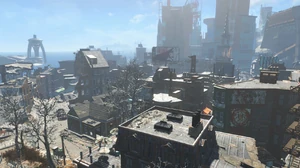
The North End was first inhabited in 1630, holding the distinction of being Boston's oldest residential district. In the 18th century, the neighborhood became a fashionable place to live, shared by wealthy families, artisans, journeymen, laborers, servants, and slaves. The district is infamous for its long history of rioting and unrest, from the Stamp Act riots of the early American Revolutionary War to religious and migrant violence throughout the 19th century, punctuated by various epidemics. It wasn't until the late 19th century and intense efforts to eradicate poverty among North End residents that fortunes turned. From the 1880s onwards, many old wooden buildings were replaced by brick and mortar architecture.[Non-game 21] A select few historical buildings were preserved, such as the former home of revolutionary hero Paul Revere (the oldest house in all of Boston),[15] as well as the Old North Church, used in 1775 by Paul Revere and Robert Newman to warn about the British advance on Concord.[16] The Freedom Trail, a tour walking route for historic landmarks of Boston, also ended in the North End, starting from the Boston Common and culminating in a stop at the Old North Church.[Non-game 22]
The North End remained largely unaffected by Boston's later modernization, living in the shadow of the superhighways cutting through Boston and the Financial District's massive skyscrapers reaching towards the sky, continuing to be a district of warm brick buildings and elegant wrought-iron balconies. The wharf continued to serve shipping interests, and life went on all the way until the Great War.[Non-game 22]
In the 2070s, the Italian mafia under Sal Barsconi controlled criminal enterprises in the North End and northern Boston. They briefly collaborated with the South Boston Irish mafia under Eddie Winter in the interest of improving relations, but this soon fell through and only widened the divide. Furthermore, this was actually a trap by Winter, directly implicating Barsconi and his associates as part of a federal investigation.[17][18] This was part of Winter's manipulation of Operation Winter's End, a task force originally set up to bring him down, ending in its complete subversion.[19][20]
Despite superficial damage, the North End weathered the nuclear holocaust surprisingly well. Even two centuries after the War, most of its buildings remain standing and in habitable condition, including the Old North Church, which the Railroad has moved into after the loss of its former headquarters, the Switchboard. The district's densely packed alleyways are also a haven for roving bands of super mutants and raiders, concealing the Railroad from prying eyes. However, other clandestine creatures stalk the night here, such as Pickman, a killer preying on the hapless raiders.[Non-game 22]
Boston Common[]
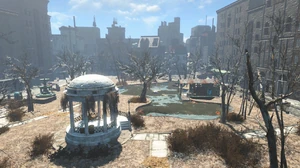
Boston Common has been called the oldest public park in all of the United States. The common was once owned by William Blaxton (the first European settler of Boston), until it was bought from him by the Puritan founders of the Massachusetts Bay Colony. Established in 1634, Boston Common started as a communal grazing ground for their cattle.[Non-game 23][21] This only lasted for a few years, as affluent families bought additional cows, which led to overgrazing. In response, grazing was limited in 1646. The Common would go on to be used for a variety of purposes, including military drills and public hangings.[Non-game 24] Directly prior to the Revolutionary War, Boston Common was used as a camp by the British infantry, from which they left to march on Concord (leading to the Battles of Lexington and Concord and the start of the Revolutionary War).[Non-game 23][21]
The Common's true status as a park seems to have emerged no later than 1830, when the grazing of cows was formally ended and renaming the Common to "Washington Park" was proposed. This did not occur, although the 1804 renaming of the bordering Sentry Street to Park Place (later to be Park Street) reflected the change in perception. By 1836, an ornamental iron fence fully enclosed the Common and its five perimeter malls or recreational promenades, the first of which, Tremont Mall, had been in place since 1728, in imitation of St. James's Park in London.[Non-game 24] Other structures on the Common's perimeter included the Boston Public Garden, officially opened in 1837 as the first public botanical garden in the United States, and the Massachusetts State House, completed in 1798 to house the state government (replacing an earlier building in the Financial District).
As time marched on and Boston grew, the Common became the nexus of the city south of the Charles River, an idyllic park surrounded by historic mansions. The Common's main attraction was its swan pond, which featured ornate swan boats which could be used by parkgoers.[Non-game 25] Another major tourist attraction was the Freedom Trail, a walking route to tour various historical sites around Boston. The trail's origin was at the Common, with its first stop at the State House before continuing further into the city.[Non-game 26]
The Common changed over the years with the advance of time and technology. Some of these changes were beneficial, such as the construction of Park Street station, providing metro service to the area,[Non-game 23] and the installation of a Protectron tour bot for historical engagement and directions for tourists following the Freedom Trail. Others were less so: the city sold so much of the surrounding land to property developers that the Public Garden was forced to merge into the Common. Consequently, the size of the swan pond was reduced several times to become that of a "glorified puddle," to the chagrin of the groundskeeper, who lamented the disappointment to tourists.[22]
Park Street station remained in service well into the 2070s, when it was purchased by the Vault-Tec Corporation to serve as a pre-excavated site to construct one of their Vaults: Vault 114 would house Boston's upper class, including its business and government elites, but in secret, it was an experiment to test said affluent residents' reactions to a Vault with cramped, communal spaces and none of the amenities that might be expected by the upper class.[23] However, the Vault remained unfinished by the time the Great War struck, whether intentionally (perhaps as a product of corruption, a scam job putting union workers on payroll for a project intended to go nowhere)[24] or not. With the Great War, the Common itself was left to decay, abandoned like much of the rest of Boston. This was the state of things until the arrival of Edgar Swann, an Institute worker turned FEV test subject who was exiled to the Commonwealth following undesirable test results. Swann made his home in the groundskeeper's shack near the swan pond. He eventually lost his mind to the effects of the FEV exposure,[25] and by 2287 has mutated into a super mutant behemoth, wearing the former swan boats as armor.
Since Swan's arrival, Boston Common has developed a fearsome reputation as a place to be avoided at all costs (ironically making it appear as one of the most peaceful places in the city). There are widespread stories that no one who enters the Common ever comes out alive, though not many know that Swan is the cause of the danger, and even his existence is subject to rumor.[26][27] This reputation is so strong that even the raiders who dominate the surrounding neighborhoods won't follow their prey into the Common,[28][Non-game 25] and various groups including the Railroad have since built numerous signs around the Common warning visitors to stay away.[Non-game 26][Non-game 23] This has not stopped people from trying, whether they are simply uninformed,[29] out of options,[30] or overly daring[27] (one raider group even set up fortifications in an attempt to take out Swan);[31] their remains are strewn around the Common, a morbid sign of the danger within.
The Common has not remained totally abandoned. For one, the Freedom Trail has been co-opted by the Railroad, who use it to make contact with outsiders who wish to seek them out.[Non-game 23] Meanwhile, despite being unfinished, Vault 114 was possibly still inhabited at some point; by 2287, regardless of any possible former owners, the Vault has since become the hideout of Skinny Malone's crew of Triggermen, who discovered the Vault after being muscled out of Goodneighbor, their old territory.[32]
Financial District[]
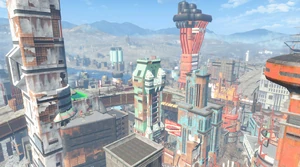
The Financial District was the commercial center of Boston, and one of the city's most modernized districts prior to the Great War. Despite the heavy development, some vestiges of historical Boston can still be seen in the district: the Old Corner Bookstore, home to the historic publishing house Ticknor and Fields and visited by many eminent authors of the mid-19th century;[33] Faneuil Hall, a colonial-era merchant hall and a stage for protest activities during the Revolutionary War;[34] and the Old State House in Scollay Square, the oldest public building in Boston and the former seat of Massachusetts' government before the construction of the "new" Massachusetts State House. Each of these landmarks became tourist stops on the Freedom Trail, which runs south-to-north through the Financial District, entering from Boston Common and continuing to the North End.
Surrounded by the elevated freeway (and monorail) providing access through and between downtown Boston, the Financial District was home to some of the tallest skyscrapers of Boston's pre-War skyline. The tallest skyscraper in Boston by height (with Trinity Tower coming close second), the Mass Fusion building (headquarters of Mass Fusion) dominated Boston's skyline with its unique architectural design, accompanied by other, smaller corporate towers such as the Baxter building or 35 Court built along Congress Street. The district was also serviced by two metro stops: Scollay Square Station and Postal Square Station.
Many of these structures did not survive the Great War intact. Over time, parts of buildings if not entire buildings have collapsed, littering the streets with their rubble. What structures are left standing often have gaping holes and whole missing sections, the tallest of which are sometimes no more than skeletal. The end result is that enterprising explorers are just as likely to fall to death as they are to succumb to the hostile super mutants, raiders, or Gunners competing for territory.[Non-game 27] Much of the elevated freeway has survived, and provides vertical access to the rooftops and upper floors of various buildings, as well as a relatively safe method of cutting through the city center.
Meanwhile, the historic Scollay Square has become the site of another settlement, Goodneighbor, founded in 2240 by criminals exiled from Diamond City.[35] It has since grown to be the second-largest settlement in the Commonwealth, home to ghouls, drifters, and outlaws who just didn't fit anywhere else.
Theater District[]
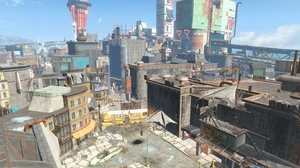
Plays were originally banned by the Puritans until 1792; Boston's first theater opened in 1793, with many more to come over the centuries, concentrated around Boylston Street and Tremont Street.[Non-game 28] One such venue was the Orpheum Theatre,[Non-game 29] first built in the mid-19th century as the Boston Music Hall. By the 2070s, the district was connected to the Boston Metro's Orange Line via the Medical Center metro, located next to the Mass Bay Medical Center which serviced patients from all around the city. After the bombs fell, the Mass Bay Medical Center was quickly commandeered by the remnants of the U.S. military to treat victims of the nuclear detonation and resulting fallout.[36][37]
Since the war, some entertainment has been revived by Southie ghoul Tommy Lonegan, who turned the Orpheum Theatre into a public cagefighting arena called the Combat Zone; it was taken over by raiders in 2285 and has been exclusive to them ever since. Meanwhile, Bosco's gang of raiders, who control much of downtown Boston,[38] are headquartered in D.B. Technical High School. Much of the rest of the district is divided between Gunners and super mutants battling each other for territory, while other locations are quieter but no less dangerous. An example is Hester's Consumer Robotics, an old robotics store close to the freeway,[Non-game 30] which is avoided by scavengers, who believe it to be a "deceptive trap."[Non-game 31]
Boston Harbor[]
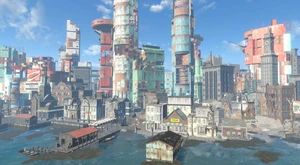
Since its discovery by John Smith in 1614, Boston Harbor has been an important port in American history, favored for its depth and its connection to the inland Charles, Mystic, and Neponset Rivers, among other factors. By 1660, almost all imports to the American colonies came to the New England coast through Boston Harbor. In 1773, the district was the site of the Boston Tea Party, a protest against British taxation of the colonies and a key event in the buildup to the Revolutionary War. The harbor was subject to backfilling as more piers and other structures were built alongside the rapid influx of immigrantion to Boston.[Non-game 32] In time, the waterfront district came to possess many landmarks of its own, such as Long Wharf, once (true to its name) the longest wharf in the harbor; The Shamrock Taphouse, one of the oldest public buildings in Boston (1787), a bar rumored to have been patronized by Paul Revere himself;[Non-game 33] and the Custom House Tower, an early 20th-century tower used by the federal government for purposes such as cargo inspection.[Non-game 34]
By pre-War times, the harbor was widely used for both recreational and commercial activities, such as swimming and fishing.[39] However, this was perhaps ill-advised: the citywide adoption of nuclear power, plus unrestricted industrial activity (and illegal dumping) by companies such as Mass Fusion, Corvega, and Saugus Ironworks, had led to radiation and heavy metals contaminating lakes, waterways, the harbor, and even the oceans at large; the Lake Quannapowitt boating incident on July 4, 2077 only served as proof of the contamination. Unlike in earlier centuries when the city actively worked to curb unrestricted sewage dumping, municipal officials turned a blind eye. Although environmental groups such as the Nahant Oceanological Society took legal or physical action[4][5] to spread awareness of how radiation was mutating marine wildlife (local crustaceans), the Boston Port Authority simply stopped taking their calls, while Galaxy News Network spun their warnings into positive news for fishing.[6]
Since the War, Boston Harbor has become littered with the hulks of wrecked ships amid other flotsam and jetsam. Now, past its shallow waters, the harbor is among the most dangerous (and soggy) neighborhoods of Boston, inhabited by mirelurks, super mutants, raiders, and occasionally unfriendly scavengers. Since the War, there have also been stories of a sea monster lurking in the harbor, though the truth is (marginally) less exciting: this "monster" is actually the Yangtze-31, a Chinese submarine which fired its warheads at Boston during the nuclear onslaught and has since been stranded by a naval mine. Over the centuries, its ghoulified captain has come to regret the suffering he helped cause.[Non-game 35]
South Boston[]
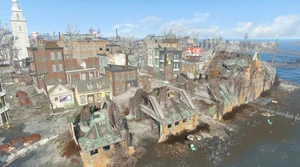
Once a densely populated neighborhood of Boston, this neighborhood features some of the most fearsome threats outside of Boston Common. It is separated from the rest of the neighborhoods by the elevated freeway remains (to the west), and Fort Point Channel and abutting Dorchester Bay (to the north and east).[Non-game 36] Geographically, Dorchester Neck was an isthmus, a narrow strip of land that connected the mainland of the colonial settlement of Dorchester with Dorchester Heights. Landfill has since greatly increased the amount of land on the eastern side of the historical neck, and widened the connection to the mainland to the point that South Boston is no longer considered separate from it.[Non-game 37]
During the American Revolutionary War, George Washington placed cannons on Dorchester Heights, thereby forcing the evacuation of British troops from Boston on March 17, 1776. The British evacuated Boston and Fort William and Mary for Halifax, Nova Scotia. Fort William and Mary was replaced with a brick fortification known as Fort Independence. That fort was replaced by a granite fortification (bearing the same name) prior to the American Civil War, and still stands on Castle Island. Once a National Historic Landmark, Edgar Allan Poe was stationed at Castle Island for five months in 1827 and was inspired to write The Cask of Amontillado based on an early Castle Island legend.[Non-game 37]
South Boston gained an identity separate from Dorchester, but the two were annexed by Boston in pieces, from 1804 to 1870. It was once known popularly as a working class Irish American neighborhood,[Non-game 37] with the neighborhood itself most popularly known as Southie.[40] That reputation didn't change in the two centuries that followed. By the 2070s, the neighborhood was serviced by the subway via Andrew station and its locale patrolled by the Boston Police Department from its local precinct.
At this time, the neighborhood was a rough one, with military blockades keeping order. Its police were known to be trigger happy, and looming over it all was the local Irish mafia, controlled by the infamous and monstrous Eddie Winter.[41] At that time, the relationship between his and the North End Italian mafia was sour. Under the guise of improvement, they would operate a job as a joint enterprise, its failure would accelerate the deterioration of their relations and implicate them directly as a part of a federal investigation.[42][43] This was a part of Winter's manipulation of Operation Winter's End, ending in its complete subversion.[44][45] His victory was short lived, as not long afterward, the Great War would occur.
Nearly two centuries later, the neighborhood would have different power brokers. Fort Independence, once again known as "The Castle" was the headquarters of the Commonwealth Minutemen. They would be driven from their stronghold by mirelurks in 2240.[Non-game 38] By 2287, the neighborhood is home to raiders (with Chancer's gang in particular operating from Andrews station), super mutants and mirelurks. A different syndicate, Marowski's, would be operating a chem lab in the Four Leaf Fishpacking plant.
West Roxbury[]
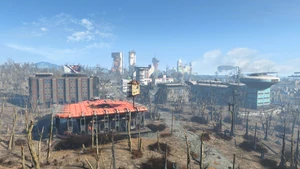
The West Roxbury township is a neighborhood of Boston, founded contemporaneously with the city in 1630. Originally a part of the town of Roxbury, as farmland, West Roxbury seceded in 1851 and was annexed by Boston in 1874, together with Jamaica Plain and Roslindale.[Non-game 39] By 2077, the township was a suburban district, housing the fully automated Milton General Hospital and the flagship Fallon's Department Store, both serviced by a large car park and the West Roxbury station. Prospective buyers could peruse cars at a local dealership just south of Fallon's.
The local living arrangements included a small housing area, overlooking the crossroads with the township's major landmarks, and the Shaw High School.
Notes[]
The city's skyscrapers make Boston viewable from most locations on the map.
Appearances[]
Boston appears in Fallout 4 and Fallout: The Board Game. It is also mentioned in Fallout 76.
Behind the scenes[]
Boston is based on the real-world Boston, Massachusetts. As featured in Fallout 4, Boston features a number of intricate differences from its real appearance. Various post-Divergence skyscrapers fill the same space as real world structures in Boston's skyline, but serve alternate purposes in the world of Fallout.
Big Dig[]
Perhaps the most present piece of alternate history is the avoidance of the infamous Big Dig. A massive multi year construction project spanning from 1982-2007. The purpose of the project was the rerouting of the elevated Central Artery of Interstate 93. The elevated highway in question, constructed between 1951 and 1959, served to connect Charlestown and the South End neighborhood, cutting directly between the Financial District and waterfront. The Central Artery was intended to allow for easier automotive transit into Boston, a city infamous for its vehicle-unfriendly historic streets. Dubbed Boston's "second green monster," the Artery was near unanimously hated by the urban population of Boston. Construction had lead to the demolition of many historic homes and disconnected the neighborhoods of downtown Boston, inconveniencing the otherwise fluid pedestrian routes of the city.[Non-game 40]
The Big Dig Project sought to demolish most of the elevated Central Artery and replace it with an underground tunnel, now named the O'Neill Tunnel. The Big Dig became the most expensive highway project in US history, facing numerous complications ranging from collapses to obstructions from the various criss-crossing utility tunnels and historic building foundations. Such complications are mirrored by the quest "The Big Dig," which follows roughly the same route as the Central Artery tunnels.[Non-game 40][46]
A product of the project was the displacement of 17 million cubic yards of dirt. The immense amounts of soil were used to cap numerous landfills in Massachusetts and Connecticut, including Spectacle Island. Further, the Quincy Quarries were filled in with dirt, resolving the cause of death for numerous teenagers who had attempted to dive into the shallow water at the bottom of the quarry.
In Fallout 4, a reverse construction project has occurred. The highways featured in the game closely follow the 1955 interstate plan for Boston featured in the "Yellow Book,"[Non-game 41] created by the U.S. Bureau of Public Roads, with the exception that they are also elevated similar to the pre-dig Central Artery. As such, Boston in the game resembles what was planned for the city in 1955, taken to an extreme. By extension, many uncapped landfills are featured in the game, the Quincy Quarries are unfilled[47], and the various tunnels built during the project are not featured in the game[48]. Spectacle Island has been covered with dirt despite the project not occurring.
Monorail[]
Hand in hand with the elevated interstate is the presence of a monorail attached on the underside of many such roadways. The monorail serves the same purpose from a transportation perspective as the absent North Station, providing rail access to central Boston.
This recent (2060s/2070s) massive construction project, and the Metro network upgrade, was beset by corruption and incompetence. The city's criminal organizations taking advantage of the situation as they normally did. The scandal was written in the Boston Bugle under the title "Heaven's Highway - Devil's Doing." by Buster Connolly. However, his assertion in the amount of involvement of the various mafia was overstated. His assertion that the safety inspector, Alice Lansky, being murdered was true.[49]
Gallery[]
Concept art[]
Screenshots[]
References[]
|
Non-game
|

